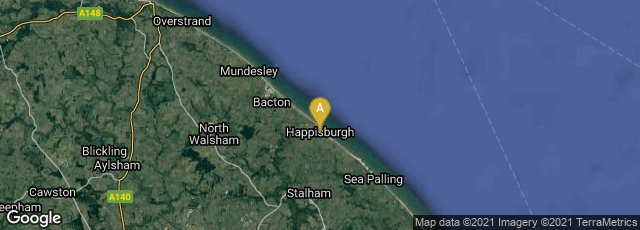

A: Happisburgh, Norwich, England, United Kingdom
Evidence from a former Thames river bed excavation site at Happisburgh in East Anglia, England, about 220 kilometers northeast of London, suggests that early humans were living in the cold climate of northern England between 780,000 and 950,000 years ago. These artefacts include 78 knapped flint specimens that the research team think were used by hunter-gatherers to pierce and cut meat or wood.
It is believed that the earliest humans moved to Europe from Africa around 1.8 million years ago, possibly crossing from Africa to Gibralter by a land bridge. It is also possible that early humans later crossed from Europe to Britain in a similar fashion. Recent evidence indicates that humans lived in Spain at Solano del Zamborino and Estrecho del Quípar, between roughly 780,000 and 950,000 years ago, but prior to the discovery of the Happisburgh site it was believed that early humans did not have the ability to adapt to the cold climates, similar to modern day Scandinavia, that would have existed in Britain at the time. Nor was it known that humans populated Britain so early. So far there is no evidence that these prehistoric inhabitants had mastered the use of fire for heating or cooking, although evidence from sites in the Middle East suggests that fire was used by other early humans at this date.
"But because they were adapted to a warmer climate, archaeologists have so far believed that they didn't get as far north as Happisburgh — a comparatively cold, inhospitable place. Other studies at archaeological sites in Germany and France have shown signs of human activity in the north around the same time, but the dating of these sites is perhaps not as well established as that at Happisburgh.
"The dating of the Happisburgh site is based on a combination of methods. The artefacts were entombed in sediment that records a reverse in the polarity of the Earth's magnetic field — the north and south poles switching places — at the time that they were laid down. The last polarity reversal is known to have been 780,000 years ago, making it probable that the Happisburgh artefacts are at least that old. . . ." (http://www.nature.com/news/2010/100707/full/news.2010.338.html, accessed 07-08-2010).
Human fossil remains have yet to be uncovered at the site, but the botanical and animal remains found there have proved very rich in detail.
Locating evidence of human habitation in a relatively cold and inhospital climate at this date is likely "to prompt a re-evaluation of the adaptations and capabilities of early humans" (http://www.npr.org/templates/story/story.php?storyId=128361420, accessed 07-08-2010).
Simon A. Parfitt, Nick M. Ashton et al. "Early Pleistocene human occupation at the edge of the boreal zone in northwest Europe," Nature 466, 8 July 2010.